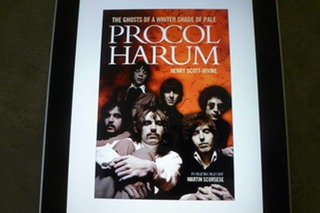Thursday, 30 May 2013

There’s a delicate balance that comes with the territory when someone ventures into the realm of music biography. If you’re writing about anyone below genuine superstar status, where almost anything anyone might want to know is already out there in the public domain you’re going to need to consider the demands of three different and quite distinct audiences.
Take a group like Procol Harum, and you’ve got a perfect encapsulation of the issue.
The first sector of the audience are the casual fans, the people who, in this case, would recall A Whiter Shade of Pale, note that they liked it, had always wondered what it was about and had always wondered about the band who took it to the top of the charts back in 1967. It’s a group who’ll find Procol Harum - The Ghosts of A Whiter Shade of Pale an interesting read, since Henry Scott-Irvine covers the band’s early history back to Gary Brooker's first outfit, The Paramounts, the Southend R&B band who might have garnered high praise from the likes of The Rolling Stones and The Beatles (who they opened for) and Sandie Shaw (who they backed on tour).
The circumstances that brought about pianist and singer Gary Brooker’s songwriting partnership with lyricist Keith Reid are covered thoroughly, as is the courtroom fallout when A Whiter Shade of Pale hit the top of the charts and former members of the band jumped in for a share of the proceeds and the more recent law suit launched by organist Matthew Fisher some thirty-eight years after the event claiming a share in the copyright of A Whiter Shade of Pale as a co-writer of the multimillion-selling song that continues to generate a strong stream of royalties.
The casual fan may well be surprised to learn that, between the original release of AWSoP and the court case Procol Harum released a string of fairly highly acclaimed albums (Shine on Brightly, A Salty Dog, Grand Hotel), toured extensively, produced some of the earliest (and best) rock collaborations in an orchestral setting and were a major drawcard in the United States through the seventies, though their prog rock credentials didn’t count for much when the punk rockers hit town.
One step up from the casual fan is the bloke who, much like myself, has heard the albums, has a bit of the sense of the chronology and wants to be reminded of the detail. Again, Scott-Irvine does a rather good job in that regard, carrying the narrative forward through the personnel changes, money problems that stemmed from dodgy management, legal costs and, in places, downright bad luck. They could, for example, have played Woodstock, but they’d already played a string of festivals that American summer and opted to head home instead.
By the book's end we're brought right up to the current incarnation of the band, a capable and congenial musical unit touring the world, dispelling ghosts as they go
It’s not, however, a book for the obsessive fan, the Procol Harum Trainspotting Anorak. While it’s an interesting, easy and enjoyable read there isn’t a great deal here that wasn’t either known or suspected. It’s quite possible the unknown and unsuspected only exists in minimal quantity, but there’s definitely room for a detailed album by album discussion of the contents of a significant though largely ignored or forgotten musical legacy.
One thing that does come across strongly is the deliberate modelling of the Procol Harum instrumental lineup on the dual keyboards piano/organ combination employed by Bob Dylan and The Hawks (later, of course, The Band) at Manchester’s Free Trade Hall and elsewhere on the 1966 World Tour, along with the influence of The Young Rascals.